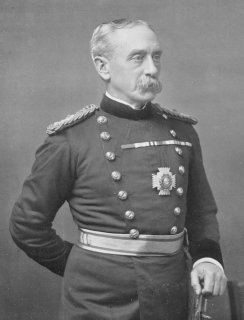Name George Wolseley Rank Lieutenant general | Died 1921 Awards Order of the Bath | |
 | ||
Battles/wars Indian MutinyAnglo-Egyptian WarMahdist War Battles and wars Indian Rebellion of 1857, Anglo-Egyptian War, Mahdist War | ||
Lieutenant-General Sir George Benjamin Wolseley, GCB (11 July 1839 – 10 May 1921) was an Anglo-Irish officer in the Indian Army.
Contents
Military career
Wolseley was the third surviving son of Major Garnet Joseph Wolseley, of the 90th Regiment of Foot (Perthshire Volunteers), by his wife Frances Anne Smith (daughter of William Smith, Co. Dublin). He was the younger brother of Field Marshal Lord Wolseley and inventor Frederick Wolseley. Wolseley's paternal grandfather was Rev. William Wolseley, Rector of Tullycorbet, and the third son of Sir Richard Wolseley, 1st Baronet, who sat in the Irish House of Commons for Carlow. The family seat was Mount Wolseley in County Carlow.
His father died in 1840, leaving a widow and seven children to survive on his Army pension. Money was short, leaving the Wolseley sons to be educated at the local school instead of being sent to England as was typical for boys of their class. He was commissioned into the 84th Regiment of Foot in 1857 and saw active service in the response to the Indian Mutiny. He became Assistant Adjutant-General with the Candahar Field Force in 1878, Assistant Adjutant-General in Egypt in 1882 (seeing action again at the Battle of Tel el-Kebir in September of that year) and Assistant Adjutant-General in the Nile Expedition of 1884. He became commander of a brigade in Burma in 1889 (which secured the town of Wuntho in 1891) and General Officer Commanding the Lahore District in India in March 1895. He went on to be General Officer Commanding the forces in the Punjab in 1897 and Commander-in-Chief Madras Command in 1898.
Family
Wolseley married, in 1867, Esther Louise Andrews, daughter of William Andrews. They had one son who died young. Lady Wolseley died at Hillside, Whitechurch, Oxfordshire, on 11 March 1902.
Death
On 10 May 1921, Wolseley's body was discovered on the train tracks of the South Eastern and Chatham Railway (now Medway Valley line) between Wateringbury and Teston in Kent. At the time of his death, he was a resident of Thatched House, Wateringbury. His death was reported as an accident.
